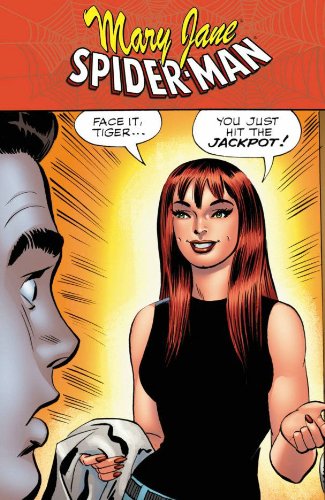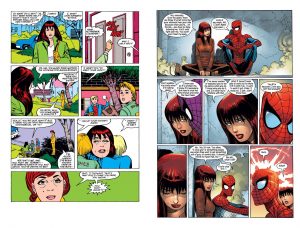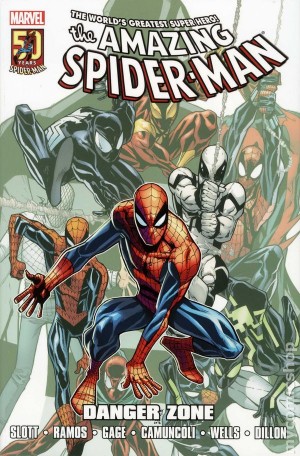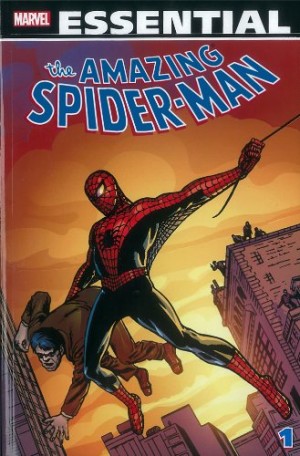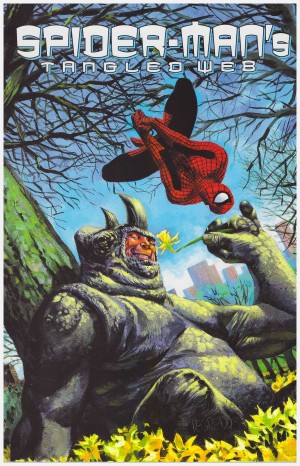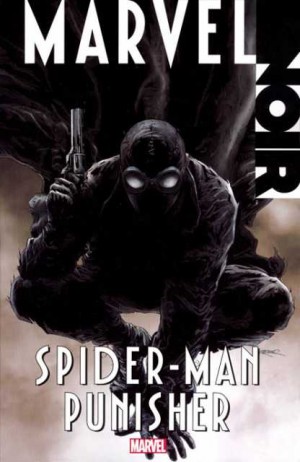Review by Ian Keogh
Until a continuity reboot in 2008 Mary Jane Watson had been Spider-Man’s wife for several years, and his girlfriend for even more years before that. This is a chronological run-through of assorted pivotal appearances.
A version of Mary Jane’s first full appearance graces the cover without being inside. That’s understandable as it was the final panel of a story. We do have the follow-up in which a pattern is set as Peter Parker has to make a sharp exit because Spider-Man needs to fight the Rhino. That’s a decent Stan Lee and John Romita tale, but Mary Jane’s presence is peripheral.
That’s not the case in Gerry Conway and Alex Saviuk’s ‘Parallel Lives’, which establishes that Mary Jane was aware of Spider-Man’s identity long before she knew Peter Parker personally. It starts well enough and slides gradually down, but Kurt Busiek and Patrick Olliffe follow-up on that tale with wit and charm. It’s the type of story Busiek delivers so well, that of the ordinary person viewing a superhero in action, a decent science-based solution to a problem and the poor luck of the early Parker. It’s ground covered yet again by Tom DeFalco, blandly drawn by Ron Frenz, but Peter and Mary-Jane’s framing conversation is emotionally resonant.
Mary Wilshire drew all too few comics, a great shame based on the annual reprinted here, which also features a credible plot from Louise Simonson. Controller of the Spider Slayer Alastiar Smythe jumps to the entirely wrong conclusion that Mary-Jane is Spider-Man, marvelling at the brilliance of her disguise! It’s dragged out a little too long, though. The Spider Slayer and Smythe return when John Romita Jr illustrates a two-part story in which Mary-Jane turns down Peter’s proposal of marriage (sample page left). Romita Jr has now been around for so long that one forgets his 1980s style, which is already very well composed. David Michelinie’s story pushes the soap opera buttons in capable fashion, but, again, the story’s extended further than the plot.
Michelinie’s still around for an issue in which Todd McFarlane’s pencilling has begun to escalate Spider-Man’s sales into the stratosphere. The work’s a combination of detail filled decoration and astoundingly distorted anatomy, but dynamically laid out. It’s a shame that editorial sloppiness doesn’t bother filling the readership in on what occurred prior to this conclusion of a multi-parter.
The best work here is by Romita Jr cemented in his more familiar style (sample art right), and part of the acclaimed Spider-Man run written by J. Michael Straczynski. The plot’s basic, featuring Captain America and Doctor Doom, but enlivened by Straczynski’s clever dialogue, decent dramatic pacing and great art. It’s a shame the lead-in’s not provided as it diminishes the effect. That can be found in The Life and Death of Spiders, or volume two of Amazing Spider-Man by JMS.
This collection was presumably issued partly to capitalise on fan anger about Mary Jane and Peter Parker being separated a year before this publication in One More Day. While including the long out of print graphic novel Parallel Lives, there are also some odd editorial choices. Why, for instance, include a story preceding the marriage of Peter and Mary Jane, in which they talk about their wedding, yet not bother reprinting the wedding itself?
It’s difficult to imagine the audience for this collection now, but given that used copies are available for little more than the price of a single new comic you may want to consider your options.
